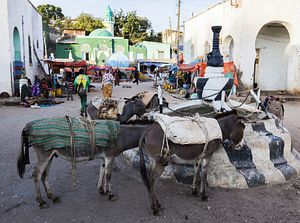Ethiopia is one of the world’s most rapidly growing economies. According to statistics from the World Bank, the country’s GDP has grown at around 10 percent per annum the last decade and this trend show no signs of stopping. Its impressive growth and relative internal stability has even earned it the sobriquet of “the African Lion,” a parallel to several East Asian states’ development in the 1960-1980s.
There are more similarities between Ethiopia and the “Asian Tigers” than just their nicknames. Ever since Ethiopia began to modernize in the late 19th century, East Asian states have often been a role-model for the country’s development. At the time, Japan was the obvious candidate for emulation; today, however, South Korea and Taiwan are often cited as a primary example for Ethiopia to follow.
The major component of this emulation includes adopting what is known as the development state model. In a nutshell, this model emphasizes stimulating economic growth through a strong state leadership and guidance. In the South Korean experience, this meant the establishment of large, family-owned businesses, in large part financed by and loyal to the ruling regime. These came to be known as the Chaebol, and dominated the Korean economy for many decades. Furthermore, these companies would initiate joint ventures with foreign corporations in order to acquire indigenously unavailable technology.
Due to low labor costs, foreign investments and government-directed spending, the Chaebol were eventually able to compete with western companies on equal terms. Many of the Chaebol are global brands today; you’d be hard pressed to find a western household that doesn’t have a Samsung, Hyundai, or LG product.
This model also has political aspects. Conveniently for authoritarian regimes, the recipe for a successful developmental state includes limiting democracy and civil liberties in the name of economic development. However, perhaps the most interesting political aspect of especially South Korea and Taiwan’s experience with the developmental state is the use of an outside, existential threat as a rallying point for the entire population. For South Korea, this was North Korea; for Taiwan, the People’s Republic of China. To a certain degree, these outside enemies justified widespread state intervention in the South Korean and Taiwanese societies (for the ultimate introduction to the South Korean and Taiwanese Developmental State models described above, Chalmers Johnson is the place to start).
The Ethiopian government has been explicit in its desire and intention to emulate Seoul and Taipei. The ruling coalition, the Ethiopian People’s Revolutionary Democratic Front (EPRDF) has explicitly adopted the development state model. Both the former, extremely influential Prime Minister Meles Zenawi and the current government under Hailemariam Dessalegn have stated that South Korea has been an important inspiration and role model for Ethiopia’s own development since the EPRDF took power in 1991.
In an interview with The Korean Herald, Ethiopian President Mulatu Teshombe stated:
Ethiopia is going through a national renaissance, following Korea’s model of development. Under a strong government guiding the national development, millions have escaped poverty and disease, and now hope for a brighter future. The general philosophy behind all of this is to have a democratic developmental state.
How does Ethiopia fit the recipe developed by Seoul and Taipei? There are some undeniable similarities. The most critical parts of the economy are still run by large state-owned enterprises (SOEs). Ethio Telecom, the Ethiopian Sugar Corporation (one of Ethiopia’s largest cash crop) and the internationally known Ethiopian Airlines all dominate or monopolize their respective economic sectors. All of these companies have at least partially been developed through joint ventures with foreign corporations.
The jewel in the crown for Ethiopia’s developmental state project is the Grand Ethiopian Renaissance Dam (GERD). When completed, this dam will be the biggest hydroelectric power plant in Africa, providing jobs to 12,000 Ethiopians and help alleviate some of the country’s chronic power shortages. Again, built with foreign technology and engineering (in this case, Italian and Chinese companies have been involved.) Sounds familiar to South Korea’s Chaebol?
In the political sphere, Ethiopia is also taking a leaf out of Syngman Rhee’s book. The EPRDF won the national elections this year in a landslide, taking every single seat in the Ethiopian parliament. According to Human Rights Watch, this was due to widespread election fraud, the imprisonment of opposition figures and a brutal crackdown on the independent media. Ring any bells, Chiang Kai-Shek?
However, when it comes to an existential threat, the Ethiopians have their own twist. Instead of an obvious foreign actor, such as al-Shaabab or antagonistic Eritrea, the EPRDF has classified poverty as its main enemy. While eradicating this foe is a commendable goal, there has to be a connection between means and ends- imprisoning or killing anyone who thinks that the government is doing a bad job might not be the best way to unite the country in the long run.
Imitation is the sincerest form of flattery. The best compliment Ethiopia could pay to its supposed role-models would be to follow them into becoming an affluent, vibrant democracy.
Benjamin David Baker is an editorial assistant at The Diplomat. Jonathan Baker is a Professor Emeritus of Development Studies at the University of Agder, Norway.

































